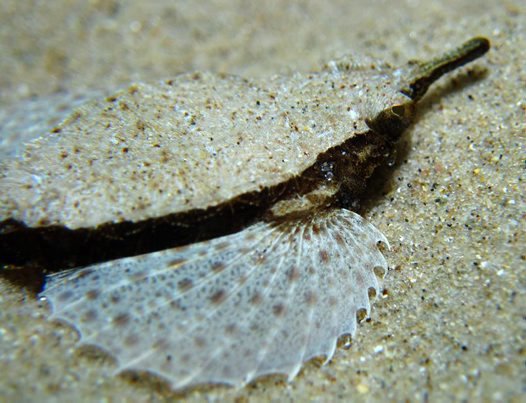Sculptured Seamoth, Pegasus lancifer Kaup, 1861
Introduction
The Sculptured Seamoth is a bottom-dwelling species that resembles a moth due to it's large horizontally directed pectoral fins and patchy colouring.
Identification
The Sculptured Seamoth has a depressed body that is encased in fused bony scale plates. It has a rostrum that is square in cross section. There is a single short based dorsal fin positioned opposite the anal fin. The pectoral fins are large and horizontally directed.
Three species of seamoths in two genera (Pegasus and Eurypegasus) occur in Australian waters. The two genera can be separated by a combination of characters including the number of tail rings (11 or more in Pegasus, 8 or 9 in Eurypegasus), deep pits behind the eyes (lacking in Pegasus, present in Eurypegasus), and the position of the eyes (not visible from below the fish in Pegasus, visible from below in Eurypegasus).

© Phil Mercurio
Habitat
It is a benthic species that occurs from intertidal depths down to at least 55 m. It is usually found in muddy, silty and sandy seabeds, often in areas of seagrass.
Distribution
The Sculptured Seamoth is endemic to Australia. It is known from eastern Victoria, around the south of the country to south-western Western Australia.
The map below shows the Australian distribution of the species based on public sightings and specimens in Australian Museums. Source: Atlas of Living Australia.
References
- Glover, C.J.M. in Gomon, M.F., Glover, C.J.M. & R.H. Kuiter (Eds). 1994. The Fishes of Australia's South Coast. State Print, Adelaide. Pp. 992.
- Kuiter, R.H. 1996. Guide to Sea Fishes of Australia. New Holland. Pp. 433.
- Kuiter, R.H. 2000. Coastal Fishes of South-eastern Australia. Gary Allen. Pp. 437.
- Palsson, W.A. & T.W. Pietsch. 1989. Revision of the Acanthopterygian Fish Family Pegasidae (Order Gasterosteiformes). Indo-Pacific Fishes. 18: 1-38.


